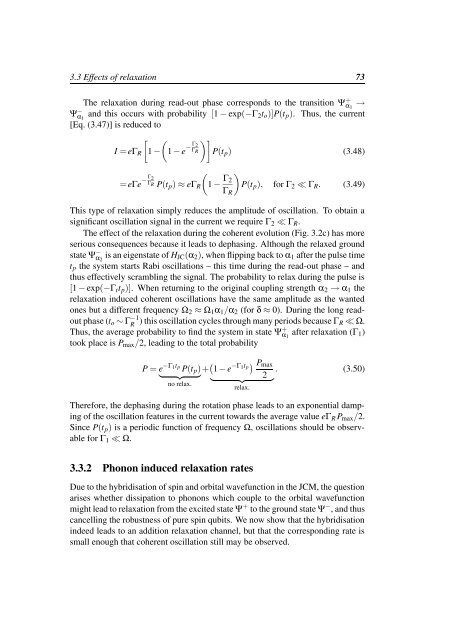Spin-orbit coupling and electron-phonon scattering - Fachbereich ...
Spin-orbit coupling and electron-phonon scattering - Fachbereich ...
Spin-orbit coupling and electron-phonon scattering - Fachbereich ...
You also want an ePaper? Increase the reach of your titles
YUMPU automatically turns print PDFs into web optimized ePapers that Google loves.
3.3 Effects of relaxation 73<br />
The relaxation during read-out phase corresponds to the transition Ψ + α 1<br />
→<br />
Ψ − α 1<br />
<strong>and</strong> this occurs with probability [1 − exp(−Γ 2 t o )]P(t p ). Thus, the current<br />
[Eq. (3.47)] is reduced to<br />
(<br />
I =eΓ R<br />
[1 − 1 − e − Γ 2<br />
Γ R<br />
)]P(t p ) (3.48)<br />
=eΓe − Γ 2<br />
Γ R P(t p ) ≈ eΓ R<br />
(1 − Γ )<br />
2<br />
P(t p ), for Γ 2 ≪ Γ R . (3.49)<br />
Γ R<br />
This type of relaxation simply reduces the amplitude of oscillation. To obtain a<br />
significant oscillation signal in the current we require Γ 2 ≪ Γ R .<br />
The effect of the relaxation during the coherent evolution (Fig. 3.2c) has more<br />
serious consequences because it leads to dephasing. Although the relaxed ground<br />
state Ψ − α 2<br />
is an eigenstate of H JC (α 2 ), when flipping back to α 1 after the pulse time<br />
t p the system starts Rabi oscillations – this time during the read-out phase – <strong>and</strong><br />
thus effectively scrambling the signal. The probability to relax during the pulse is<br />
[1 − exp(−Γ t t p )]. When returning to the original <strong>coupling</strong> strength α 2 → α 1 the<br />
relaxation induced coherent oscillations have the same amplitude as the wanted<br />
ones but a different frequency Ω 2 ≈ Ω 1 α 1 /α 2 (for δ ≈ 0). During the long readout<br />
phase (t o ∼ Γ −1<br />
R ) this oscillation cycles through many periods because Γ R ≪ Ω.<br />
Thus, the average probability to find the system in state Ψ + α 1<br />
after relaxation (Γ 1 )<br />
took place is P max /2, leading to the total probability<br />
P = e −Γ 1t p<br />
P(t p )<br />
} {{ }<br />
no relax.<br />
+ ( 1 − e −Γ 1t p<br />
) P max<br />
2<br />
} {{ }<br />
relax.<br />
. (3.50)<br />
Therefore, the dephasing during the rotation phase leads to an exponential damping<br />
of the oscillation features in the current towards the average value eΓ R P max /2.<br />
Since P(t p ) is a periodic function of frequency Ω, oscillations should be observable<br />
for Γ 1 ≪ Ω.<br />
3.3.2 Phonon induced relaxation rates<br />
Due to the hybridisation of spin <strong>and</strong> <strong>orbit</strong>al wavefunction in the JCM, the question<br />
arises whether dissipation to <strong>phonon</strong>s which couple to the <strong>orbit</strong>al wavefunction<br />
might lead to relaxation from the excited state Ψ + to the ground state Ψ − , <strong>and</strong> thus<br />
cancelling the robustness of pure spin qubits. We now show that the hybridisation<br />
indeed leads to an addition relaxation channel, but that the corresponding rate is<br />
small enough that coherent oscillation still may be observed.
















